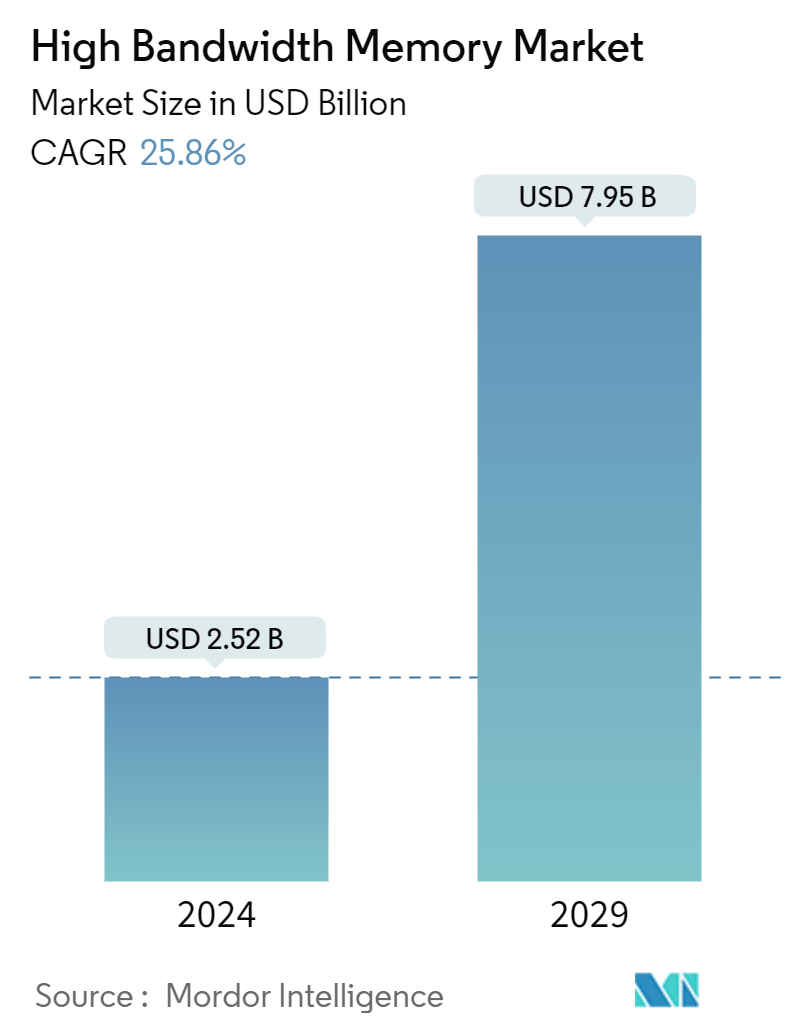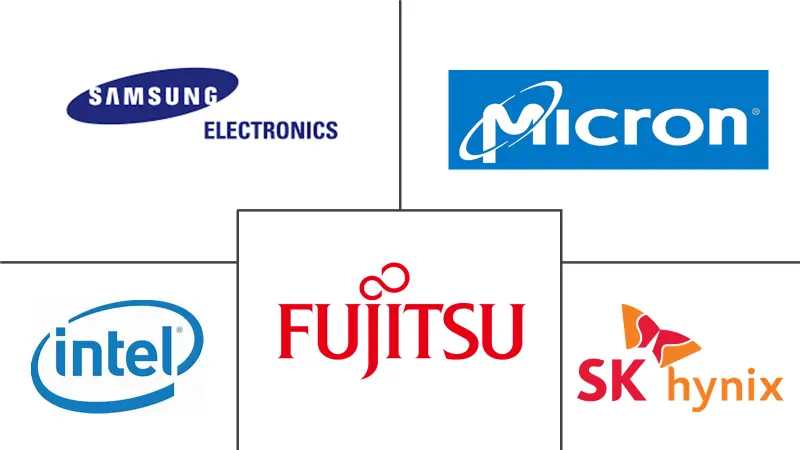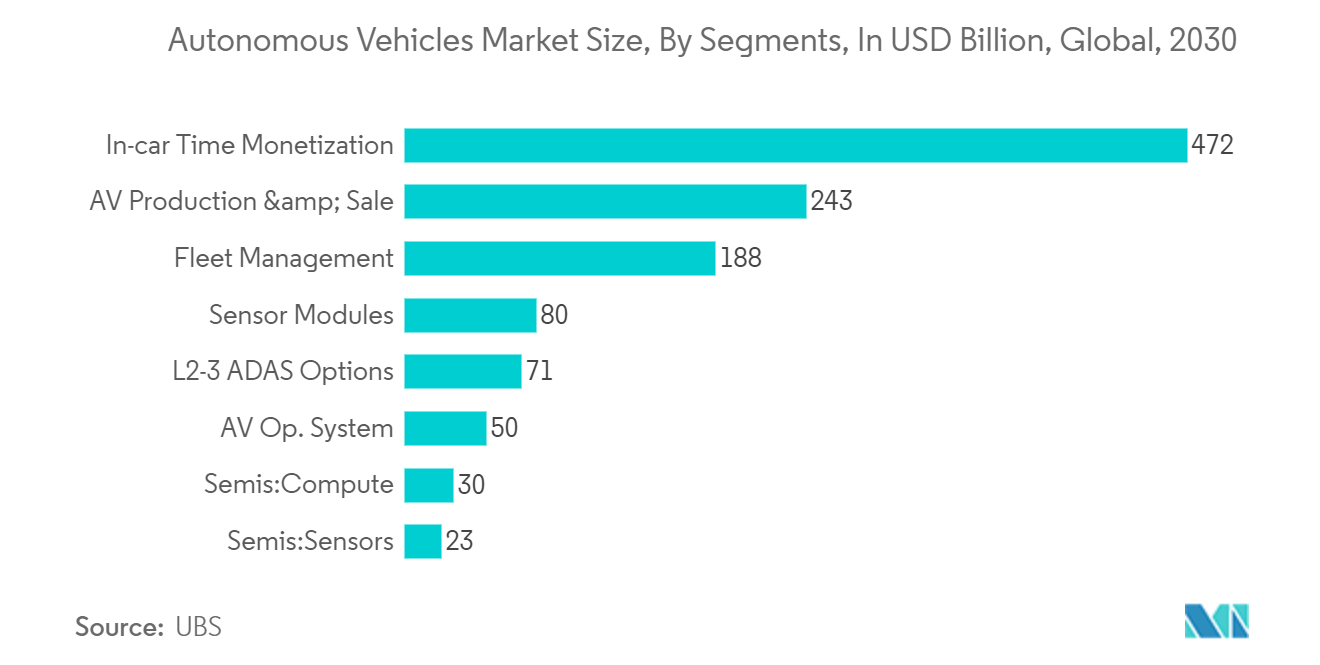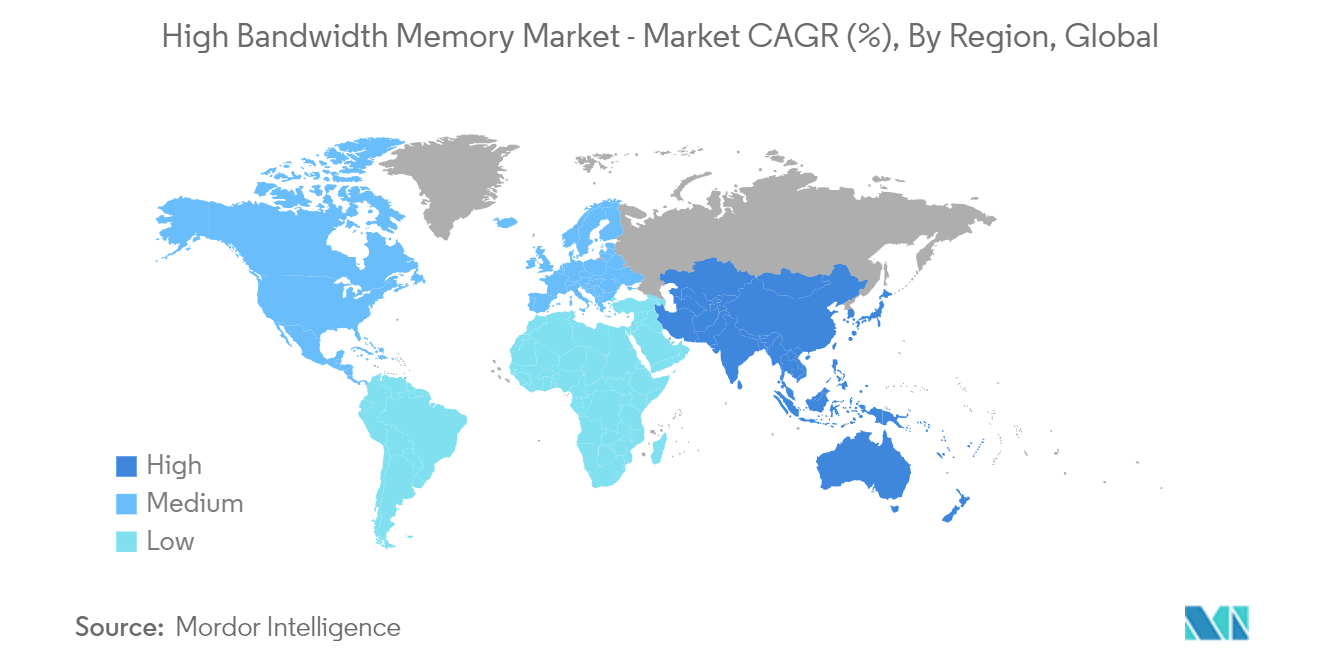High Bandwidth Memory Market Size

| Study Period | 2019 - 2029 |
| Market Size (2024) | USD 2.52 Billion |
| Market Size (2029) | USD 7.95 Billion |
| CAGR (2024 - 2029) | 25.86 % |
| Fastest Growing Market | Asia Pacific |
| Largest Market | North America |
Major Players
*Disclaimer: Major Players sorted in no particular order |
High Bandwidth Memory Market Analysis
The High Bandwidth Memory Market size is estimated at USD 2.52 billion in 2024, and is expected to reach USD 7.95 billion by 2029, growing at a CAGR of 25.86% during the forecast period (2024-2029).
High bandwidth memory (HBM) is a high-speed computer memory interface for 3D-stacked SDRAM, usually used with high-performance graphics accelerators, network devices, and supercomputers.
Major factors driving the growth of the high bandwidth memory (HBM) market include the growing need for high bandwidth, low power, and highly scalable memories, increasing adoption of artificial intelligence, and a rising trend of miniaturization of electronic devices.
By stacking up 8 DRAM dies on the circuit and interconnecting them with TSVs, HBM offers a substantially higher bandwidth while using less power in a relatively minor form factor. Also, with 128-bit channels and a total of 8 channels, the HBM offers a 1,024-bit interface. A GPU with four HBM stacks would provide a memory bus with 4,096 bits.
For instance, in June 2024, US memory chip maker Micron Technology built test production lines for advanced high bandwidth memory chips in the United States. The company is considering manufacturing HBM in Malaysia for the first time to capture more demand from the AI boom.
With the growing graphics application, the appetite for fast information delivery (bandwidth) has also increased. Therefore, HBM performs better than GDDR5, which was used earlier in terms of performance and power efficiency, resulting in growth opportunities for the high bandwidth memory market.
Moreover, the major semiconductor vendors worked with reduced capacity due to the COVID-19 pandemic. Additionally, due to the shortage of laborers, many packages and testing plants in China reduced or even stopped operations. This created a bottleneck for chip companies that rely on such back-end packages and testing capacity.
However, some factors driving the market's growth include the increasing adoption of artificial intelligence, increasing demand for low power consumption, high bandwidth, highly scalable memories, and a rising trend of miniaturization of electronic devices.
High Bandwidth Memory Market Trends
The Automotive and Other Applications Segment is Expected to Grow Significantly
- The applications of high bandwidth memory are spanning the automotive industry due to the rise of self-driving cars and ADAS integration. Advancements in the automotive industry have driven the adoption of high-performance memory, which supports the growth of the HBM market.
- HBM has evolved by improving upon conventional DRAM using 2.5D technology, bringing it closer to the CPU while requiring less power to drive a signal and minimizing RC latency. The autonomous driving market is expanding, extensively using data sets to interpret and analyze the environment. In order to prevent mishaps and impending catastrophes, data processing is carried out at a very rapid pace. The demand for quick and potent GPUs has increased the demand for high bandwidth memory to be included in the systems.
- In March 2024, Samsung Electronics Co., a memory chipmaker, set up a high bandwidth memory (HBM) team within the memory chip division to raise production yields as it is developing a sixth-generation AI memory HBM4 and AI accelerator Mach-1. The new team is in charge of the development and sales of DRAM and NAND flash memory.
- Advanced driver-assistance technologies have become quite popular in the car industry alongside autonomous driving. Earlier ADAS designs used memory chips like DDR4 and LPDDR4 since they were readily available at the time. However, the automobile industry's transition from cost-effectiveness to better performance parameters pushes ADAS makers to incorporate HBM technology into their design architecture.
- The rapid advancement of technology in automobiles and increasing usage of edge technologies in cars are expected to boost the sales of high bandwidth memory and DDRAM in the market studied.

North America to Hold the Largest Share in the Market
- The high adoption of HBMs in North America is primarily due to the growth in high-performance computing (HPC) applications that require high bandwidth memory solutions for fast data processing. HPC demand in North America is growing due to the increase in demand for AI, machine learning, and cloud computing.
- The rapidly changing technologies and high data generation across industries create a need for efficient processing systems. These are also some of the factors driving the demand for the high bandwidth memory market in the region.
- Additionally, the US government started the Data Center Optimization Initiative (DCOI) to deliver better services to the public while increasing return on investment to taxpayers by consolidating many data centers in the country. The consolidation process includes building hyper-scale data centers and shutting off the underperforming ones. According to Cloudscene, the country had around 5,381 data centers in the United States as of March 2024.
- Memory manufacturing companies in North America are seeking opportunities for product expansions. For instance, Intel announced the launch of the next generation Sapphire Rapids (SPR) Xeon Scalable processor with high bandwidth memory (HBM). DDR5, supported by Sapphire Rapids, is expected to replace DDR4, the current trend in server memory, with high bandwidth memory (HBM) support, which may significantly expand the memory bandwidth available to the CPU.

High Bandwidth Memory Industry Overview
The high bandwidth memory market is highly fragmented. The market is highly competitive and consists of several major players. This industry's competitive rivalry primarily depends on sustainable competitive advantage through innovation, market penetration, and competitive strategy power. Since the market is capital-intensive, the barriers to exit are also high. Some of the key players in the market are Intel Corporation, Toshiba Corporation, and Fujitsu Ltd.
- April 2024 - TSMC signed a Memorandum of Understanding with SK Hynix to develop next-generation HBM (high bandwidth memory) and a next-generation packaging technology. SK Hynix intends to utilize TSMC’s sophisticated logic processes for the foundational component of HBM4, aiming to incorporate more features within the confined space, which is anticipated to boost both the performance and energy efficiency of its memory chips.
- March 2024 - Camtek Ltd announced that it received a new order for approximately USD 25 million from a tier-1 HBM manufacturer for the inspection and metrology of high bandwidth memory (HBM). Most of the systems are expected to be delivered in the second half of 2024.
High Bandwidth Memory Market Leaders
-
Micron Technology, Inc.
-
Samsung Electronics Co. Ltd.
-
SK Hynix Inc.
-
Intel Corporation
-
Fujitsu Limited
*Disclaimer: Major Players sorted in no particular order
-Market-CL-Logo.webp)
High Bandwidth Memory Market News
- July 2024 - Huawei collaborated with Wuhan Xinxin Semiconductor Manufacturing to create high bandwidth memory (HBM) chips. Both companies will be offering CoWoS (chip-on-wafer-on-substrate) technology, a packaging process that connects a GPU, a logic chip, and HBM on a special substrate called an interposer.
- March 2024 - Nvidia announced its plans to procure high bandwidth memory (HBM) chips, which is a crucial component in AI processors, from Samsung, as the South Korean electronics player tries to catch up with rival SK Hynix, which recently started mass production of its next-generation HBM chip.
High Bandwidth Memory (HBM) Market Report - Table of Contents
1. INTRODUCTION
- 1.1 Study Assumptions and Market Definition
- 1.2 Scope of the Study
2. RESEARCH METHODOLOGY
3. EXECUTIVE SUMMARY
4. MARKET INSIGHTS
- 4.1 Market Overview
- 4.2 Industry Value Chain Analysis
-
4.3 Industry Attractiveness - Porter's Five Forces Analysis
- 4.3.1 Bargaining Power of Suppliers
- 4.3.2 Bargaining Power of Buyers/Consumers
- 4.3.3 Threat of New Entrants
- 4.3.4 Threat of Substitutes
- 4.3.5 Intensity of Competitive Rivalry
- 4.4 Assessment of the Impact of COVID-19 on the Market
-
4.5 Market Drivers
- 4.5.1 Growing Need for High Bandwidth, Low Power Consuming, and Highly Scalable Memories
- 4.5.2 Increasing Adoption of Artificial Intelligence
- 4.5.3 Rising Trend of Miniaturization of Electronic Devices
-
4.6 Market Challenges
- 4.6.1 Exorbitant Costs and Design Complexities Associated with HBM
-
4.7 DRAM MARKET
- 4.7.1 DRAM Revenue and Demand Forecast (2023-2028)
- 4.7.2 DRAM Revenue by Geography (Same Geographical Regions as in the HBM Market)
- 4.7.3 Current Pricing of DDR5 RAM Products
- 4.7.4 List of DDR5 Product Manufacturers
5. MARKET SEGMENTATION
-
5.1 By Application
- 5.1.1 Servers
- 5.1.2 Networking
- 5.1.3 Consumer
- 5.1.4 Automotive and Other Applications
-
5.2 By Geography
- 5.2.1 North America
- 5.2.1.1 United States
- 5.2.1.2 Canada
- 5.2.2 Europe
- 5.2.2.1 Germany
- 5.2.2.2 France
- 5.2.2.3 United Kingdom
- 5.2.2.4 Rest of Europe
- 5.2.3 Asia-Pacific
- 5.2.3.1 India
- 5.2.3.2 China
- 5.2.3.3 Japan
- 5.2.3.4 Rest of Asia-Pacific
- 5.2.4 Rest of the World
6. COMPETITIVE LANDSCAPE
-
6.1 Company Profiles
- 6.1.1 Key HBM Memory Die Suppliers
- 6.1.1.1 Micron Technology Inc.
- 6.1.1.2 Samsung Electronics Co. Ltd
- 6.1.1.3 SK Hynix Inc.
- 6.1.2 Key Stakeholders Profiles
- 6.1.2.1 Intel Corporation
- 6.1.2.2 Fujitsu Limited
- 6.1.2.3 Advanced Micro Devices Inc.
- 6.1.2.4 Xilinx Inc.
- 6.1.2.5 Nvidia Corporation
- 6.1.2.6 Open Silicon Inc.
- *List Not Exhaustive
7. INVESTMENT ANALYSIS
8. MARKET OPPORTUNITIES AND FUTURE TRENDS
** Subject To AvailablityHigh Bandwidth Memory Industry Segmentation
High bandwidth memory (HBM) is the high-speed computer memory interface for 3D-stacked synchronous dynamic random-access memory (SDRAM). It works with high-performance network hardware, high-performance data center AI ASICs, FPGAs, and supercomputers.
The high bandwidth memory (HBM) market is segmented by application (servers, networking, consumer, and automotive and other applications) and geography (North America [United States and Canada], Europe [Germany, France, United Kingdom, and Rest of Europe], Asia-Pacific [India, China, Japan, and Rest of Asia-Pacific], and Rest of the World).
The market sizes and forecasts are provided in terms of value (USD) for all the above segments.
| By Application | Servers | |
| Networking | ||
| Consumer | ||
| Automotive and Other Applications | ||
| By Geography | North America | United States |
| Canada | ||
| By Geography | Europe | Germany |
| France | ||
| United Kingdom | ||
| Rest of Europe | ||
| By Geography | Asia-Pacific | India |
| China | ||
| Japan | ||
| Rest of Asia-Pacific | ||
| By Geography | Rest of the World |
High Bandwidth Memory (HBM) Market Research FAQs
How big is the High Bandwidth Memory Market?
The High Bandwidth Memory Market size is expected to reach USD 2.52 billion in 2024 and grow at a CAGR of 25.86% to reach USD 7.95 billion by 2029.
What is the current High Bandwidth Memory Market size?
In 2024, the High Bandwidth Memory Market size is expected to reach USD 2.52 billion.
Who are the key players in High Bandwidth Memory Market?
Micron Technology, Inc., Samsung Electronics Co. Ltd., SK Hynix Inc., Intel Corporation and Fujitsu Limited are the major companies operating in the High Bandwidth Memory Market.
Which is the fastest growing region in High Bandwidth Memory Market?
Asia Pacific is estimated to grow at the highest CAGR over the forecast period (2024-2029).
Which region has the biggest share in High Bandwidth Memory Market?
In 2024, the North America accounts for the largest market share in High Bandwidth Memory Market.
What years does this High Bandwidth Memory Market cover, and what was the market size in 2023?
In 2023, the High Bandwidth Memory Market size was estimated at USD 1.87 billion. The report covers the High Bandwidth Memory Market historical market size for years: 2019, 2020, 2021, 2022 and 2023. The report also forecasts the High Bandwidth Memory Market size for years: 2024, 2025, 2026, 2027, 2028 and 2029.
HBM Industry Report
Statistics for the 2024 HBM market share, size and revenue growth rate, created by Mordor Intelligence™ Industry Reports. HBM analysis includes a market forecast outlook to 2029 and historical overview. Get a sample of this industry analysis as a free report PDF download.



